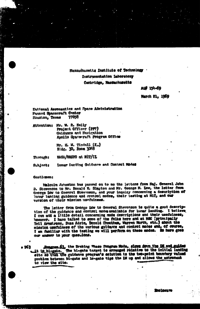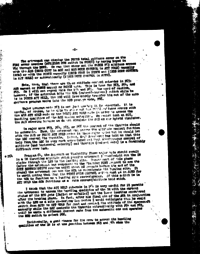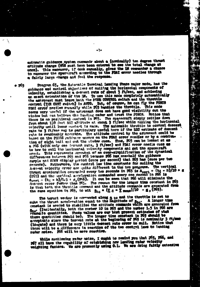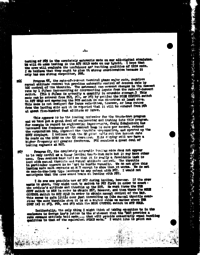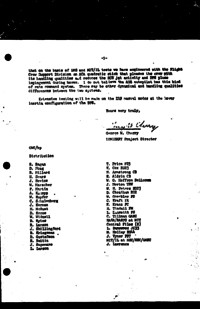Mr. W. R. Kelly Project Officer (PP7) Guidance and Navigation Apollo Spacecraft Program Office Mr. H. W. Tindall (FM) Bldg. 30, Room 3068March 21, 1969AG 154-69Lunar Landing Guidance and Control Modes
Gentlemen:
Malcolm Johnston has passed on to me the letters from Maj. General John D. Stevenson to Mr. Donald K. Slayton and Mr. George M. Low, the letter from George Low to General Stevenson, and your inquiry concerning a description of lunar landing guidance and control modes, their testing at MIT, and our version of their mission usefulness.
The letter from George Low to General Stevenson is quite a good descrip- tion of the guidance and control modes available for lunar landing. I believe I can add a little detail concerning mode descriptions and their usefulness, however. I have talked to some of the folks here and at MSC (principally Neil Armstrong, Buzz Aldrin, Donald Cheatham, Warren North, etc.) about the mission usefulness of the various guidance and control modes and, of course, I am familiar with the testing we will perform on these modes. So here goes our answer to your questions.
Program 63, the Braking phase Program Mode, slows down the LM and guides it to hi-gate. The hi-gate target is arranged relative to the initial landing site so that the guidance program's solution to the two-point boundary valued problem between hi-gate and lo-gate tips the LM up and allows the astronaut to view the site.
The astronaut can display the PGNCS total guidance error on the FDAI error needles (ATTITUDE MON switch in PGNCS) by having keyed in V62 through the DSKY. He can then steer out the PGNCS P63 attitude errors with the AGS (GUID CONT in AGS and AGS MODE CONTROL in ATT HOLD) manually (ACA) or with the PGNCS manually (GUID CONT in PGNCS and PGNCS MODE CONTROL in ATT IDLE) or automatically (PGNCS MODE CONTROL in AUTO).
Note, then, that there are three attitude control submodes in P63: AGS manual or PGNCS manual or PGNCS auto. This is true for P63, P64, and P65. So I will not repeat this for P64 and P65. One word of caution, however, if the astronaut hits the ROD (rate-of-descent) switch while he is in PGNCS ATT HOLD, the LGC will irrevocably transfer him out of the auto guidance program modes into the ROD program mode, P66.
Major program mode P63 is not just useful; it is essential. It is useful, of course, to be able to steer out the PGNCS guidance errors with the AGS ATT HOLD mode or the PGNCS ATT HOLD mode in order to assess the handling qualities of the AGS analog autopilot. We cannot test at MIT, the AGS steering because we do not simulate the AGS on our hybrid simulator.
In major mode P63, P64, P65, or P66 the control of the throttle should be automatic. Thus, the astronaut can assume the attitude control function with the AGS or PGNCS ATT HOLD modes in these major modes but he should let the LGC control the throttle. Indeed, Neil Armstrong has told me that this help from the LGC is very much appreciated and that simultaneous control of attitude (and horizontal velocity) and throttle (descent rate) is a formidably difficult crew task.
Program 64, the Approach or Visibility Phase major mode should result in a LM thrusting attitude which permits astronaut line-of-sight out the LM window through the LPD to the landing site. During most of this phase (after the astronaut has responded to the flashing DSKY request to arm the SITE REDESIGNATION routine until about 20 seconds before the end of the phase) the astronaut can use the ACA to redesignate the landing site. It is worth noting that that the PGNCS MODE CONTROL switch must be in AUTO for the ACA to function as a landing site re-designator. If this switch is in ATT HOLD the ACA functions as a rate command/attitude hold stick.
I think that the ATT HOLD sub-mode in P64 is very useful for it permits the astronaut to assess the handling qualities of the LM with the current status of the RCS jets (failed or unfailed) and the lower inertias encountered after the braking phase. In fact, after his final use of the ACA in conjunction with the LPD as a site re-designation device I would anticipate that he would switch from AUTO to ATT HOLD for good and control the attitude of the spacecraft manually while the LGC controls the throttle automatically with P64 and P65, until he wants a different descent rate from the automatic one and operates the ROD switch to select P66.
Incidentally, a good chance for the crew to assess the handling qualities of the LM is at the junction between P63 and P64 when the automatic guidance system commands about a (nominally) ten degree thrust attitude change (V62 must have been entered to see the total change at once). This maneuver, if done manually, gives the LM commander a chance to maneuver the spacecraft according to the FDAI error needles through a fairly large change and feel the response.
Program 65, the Automatic Terminal Landing Phase major mode, has the guidance and control objectives of nulling the horizontal components of velocity, establishing a descent rate of about 3 ft/sec, and achieving an erect orientation of the LM. To use this mode completely automatically the astronaut must leave both the MODE CONTROL switch and the throttle control (THR CONT switch) in AUTO. But, of course, he can fly the PGNCS FDAI error needles manually while P65 handles the throttle. This mode seems very useful if the astronaut does not have good visibility out the windows but can believe the landing radar an trust the PGNCS. Notice that there is no positional control in P65. The spacecraft simply settles down from about 150 feet LGC altitude at about 3 ft/sec while nulling the horizontal velocity until lunar contact is made. The automatic throttle to control descent rate to 3 ft/sec may be particularly useful here if the LGC estimate of descent rate is reasonably accurate. The attitude control by the astronaut could be based on the PGNCS guidance errors on the FDAI error needles or by a combina- tion of eight ball and out the window cues. Thus, P65 can be looked at as a P66 (with only one descent rate, 3 ft/sec) and FDAI error needle cues as to how to null the horizontal velocity components and get the spacecraft erect. This represents somewhat of an over-simplification of the dynamical differences between P65 and P66 because P66 has one-half the guidance sample and DSKY display period (once per second) that P65 has (once per two seconds). Furthermore, the control law time constants for nulling the descent velocity error are quite different in the two programs. The vertical thrust acceleration commanded every two seconds in P65 is Avert = (hd – h)/10 + g (P65) and the vertical acceleration commanded every one second in P66 is Avert = (hd – h)/1.5 + g (P66). It can be seen that P66 will eliminate the descent error faster than P65. The reason for the longer time constant in P65 is that both the throttle command and the attitude commands are generated from the same equation in P65, to wit atc = (V d – V meas)/10 – g, (P65).
The thrust vector is commanded along a tc and the throttle is set to make the thrust acceleration equal to the magnitude to atc. A longer time constant is needed to stabilize the attitude commands which are generated from atc. (Incidentally, both the number 10 in P65 and the number 1.5 in P66 are erasable quantities. These values are our best present estimates of what these quantities should be). The longer time constant in P65 should be acceptable since the descent rate at the beginning of P65 is nominally 3 ft/sec (lo-gate) and there is very little descent rate error to null. Notice that there will be a difference in reaction of the two control laws to landing radar noise. P66 will be more reactive.
While mentioning radar noise, I ought to remind you that P65, P66, and P67 all have the capability of establishing new landing radar velocity weighting factors. We are presently using 0.1. We are doing fairly extensive testing Of P65 in the completely automatic mode on our all-digital simulator. We will do some testing in the ATT HOLD mode on our hybrid. I hope that the crew will evaluate the usefulness and handling qualities of this mode. I do believe that they ought to give it strong consideration because it only has one strong competitor, P66.
Program 66, the rate-of-descant terminal phase major mode, requires manual attitude control but provides automatic control of descent rate by LGC control of the throttle. The astronaut can command changes in the descent rate by 1 ft/sec incrementing or decrementing inputs from the rate-of-descent switch. (The 1 ft/sec is actually a quantity in erasable storage.) This mode can to entered from P63, P64, or P65 by putting the MODE CONTROL switch in ATT HOLD and operating the ROD switch in one direction at least once. This mode is not designed for large velocities, however, or long ranges from the landing site and it is expected that it will be entered from P64 at about five-hundred feet altitude or later.
This appears to be the leading contender for the touch-down program and we have put a great deal of engineering and testing into this program. For example in regard to engineering improvements, Craig Schulenberg has increased the frequency of the control loop to once per second, reduced the computation log, improved the throttle compensation, and speeded up the DSKY displays. I believe that the LM pilot calls out the descent rate he reads on the DSKY to the LM commander. This display will now have a highr frequency and greater freshness. P66 receives a great deal of testing emphasis at MIT.
Program 67, the completely automatic landing mode does not appear to be very useful as a lunar landing touch-down mode but it may have other uses. Crew members have told me that it is really a formidable task to land with manual throttle and manual attitude control. The throttle in particular appears to be hard to handle manually. We do not give this landing mode much emphasis at MIT except to show that it works. We do not do man-in-the-loop type landings to any extent with P67. I would not anticipate that the crew would train on landing with P67.
I do see one possible use of P67 during landing, however. If the crew wants to abort, they might want to switch to P67 first in order to erect the vehicle's attitude and throttle up the DPS. He must throw the THR CONT switch to MAN in order to obtain P67, however, and then throw the MODE CONTROL switch to ATT HOLD in order to obtain manual control of the DAP. This seems to gain little over just throttling up (the manual throttle over- rides the auto throttle when it is at a higher value no matter where THR CONT is) in P63, P64, and P65 with the MODE CONTROL switch in ATT HOLD.
Incidentally, the only thing I might think of taking exception to in the enclosure to George Low's letter is the statement that the “AGS provides a rate command attitude hold mode…. that will provide essentially equal handling qualities to that of the equivalent PGNCS mode.” I would like to point out that on the basis of LMS and MIT/IL tests we have engineered with the Flight Crew Support Division on ACA quadratic stick that pleases the crew with its handling qualities and reduces the RCS jet activity and DPS plume impingement during hover. I do not believe the AGS autopilot has this kind of rate command system. There may be other dynamical and handling qualities differences between the two systems.
Extensive testing will be made on the DAP manual modes at the hover inertia configuration of the DPS.
- Jan 07, 1970 – Important LM computer program change for Apollo 13 descent (7.8σ)
- May 29, 1968 – Spacecraft computer program – things dealing with lunar descent and aborts from it (4.6σ)
- May 28, 1969 – Descent, Lunar Surface, and Ascent Mission Techniques with the H crew (4.4σ)
- Nov 09, 1967 – MIT/MSC review of LUMINARY Descent Programs (3.2σ)
- Oct 29, 1969 – Don’t turn off the landing radar (3.2σ)

